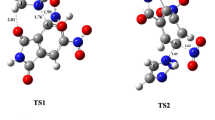Abstract
The density functional theory (DFT) calculations at B3LYP/6-31 + G(d,p) level were performed for a series of new 2,4,6-cycloheptatriene-1-imine scaffolds which have potential to introduce as organosuperbases. In the present study, we have exploited the 2,4,6-cycloheptatriene-1-imines which strategically substituted at 2 and 7 positions by two potential anchoring arms having lone pair possessing atoms. The designed organic superbases were found to have the higher basicity than the benchmarked molecule, 1,8-bis(dimethylamino)-naphthalene. The proposed superbase B14 bearing guanidine and aniline groups possesses the highest proton affinity value as 1143.8 kJ mol−1. The protonation enthalpy, Gibbs free energy, harmonic oscillator model of aromaticity (HOMA), and nucleus-independent chemical shift (NICS) were used for the basicity comparison. After the protonation of the designed molecules, the positive charge on the conjugate acid is expected to be delocalized in the cycloheptatriene ring and led to its aromatization. The results indicate that the HOMA and NICS values of the ring in the conjugate acid are strongly elevated. On the other hand, very strong intramolecular hydrogen bonding is formed after protonation. These two factors enhance the stability of the conjugate acids and thereby increase the basicity of the designed molecules.






Similar content being viewed by others
References
Alder RW, Bowman PS, Steele WRS, Winterman DP (1968). Chem Commun 1968:723–724
Bell RP (1973) The proton in chemistry. Cornell University Press, Ithaca
Warren JJ, Mayer JM (2015). Biochemistry 54:1863–1878
Jessop PG, Heldebrant DJ, Li XW, Eckert CA, Liott CL (2005). Nature 436:102–1102
Biswas AK, Lo R, Si MK, Ganguly B (2014). Phys Chem Chem Phys 16:12567–12575
Yang Z, He L, Zhao Y, Li B, Yu B (2011). Energy Environ Sci 4:3971–3975
Lo R, Singh A, Kesharwani MK, Ganguly B (2012). Chem Commun 48:5865–5867
Glasovac Z, Trukil VŠ, Eckert-Maksić M, Schröder D, Kaczorowska M, Schwarz H (2008). Int J Mass Spectrom 270:39–46
Biswas AK, Ganguly B (2017). Chem Eur J 21:2700–2705
Maksić ZB, Kovaćević B, Vianello R (2012). Chem Rev 112:5240–5270
Raczyńska ED, Gal J, Maria P (2016). Chem Rev 116:13454–13511
Margetić D (2009) In: Ishikawa T (ed) Superbases for organic synthesis: guanidines, amidines, phosphazenes and related organocatalysts. Wiley, Chichester
Saadat K, Shiri A, Kovačević B (2018). New J Chem 42:14568–14575
Despotovic I, Vianello R (2014). Chem Commun 50:10941–10944
Kovacevic B, Despotovic I, Maksic ZB (2007). Tetrahedron Lett 48:261–264
Raab V, Gauchenova E, Merkoulov A, Harms K, Sundermeyer J, Kovačević B, Maksić ZB (2005). J Am Chem Soc 127:15738–15743
Alder RW (1989). Chem Rev 89:1215–1223
Bachrach SM (2013). J Organomet Chem 78:10909–10916
Tian Z, Fattahi A, Lis L, Kass SR (2009). Croat Chem Acta 82:41–45
Bachrach SM, Wilbanks CC (2010). J Organomet Chem 75:2651–2660
Bachrach SM (2019). J Organomet Chem 84:3467–3476
Barić D, Dragičević I, Kovačević B (2013). J Organomet Chem 78:4075–4082
Saeidian H, Barfinejad E (2019). ChemistrySelect 4:3088–3095
Valadbeigi Y (2017). Chem Phys Lett 689:1–7
Bandar JS, Lambert TH (2012). J Am Chem Soc 134:5552–5555
Despotović I, Maksić ZB, Vianello R (2007). New J Chem 31:52–62
Frisch MJ, Trucks GW, Schlegel HB, Scuseria GE, Robb MA, Cheeseman JR, Zakrzewski VG, Montgomery JA, Jr Stratmann RE, Burant JC, Dapprich S, Millam JM, Daniels AD, Kudin KN, Strain MC, Farkas O, Tomasi J, Barone V, Cossi M, Cammi R, Mennucci B, Pomelli C, Adamo C, Clifford S, Ochterski J, Petersson GA, Ayala PY, Cui Q, Morokuma K, Salvador P, Dannenberg JJ, Malick DK, Rabuck AD, Raghavachari K, Foresman JB, Cioslowski J, Ortiz JV, Baboul AG, Stefanov BB, Liu G, Liashenko A, Piskorz P, Komaromi I, Gomperts R, Martin RI, Fox DJ, Keith T, Al-Laham MA, Peng CY, Nanayakkara A, Challacombe M, Gill PMW, Johnson BG, Chen W, Wong MW, Andres JL, Gonzalez C, Head-Gordon M, Replogle ES, Pople JA (2013) Gaussian 09. Gaussian, Inc, Wallingford
Porannea RG, Stanger A (2015). Chem Soc Rev 44:6597–6615
Krygowski TM, Szatylowicz H, Stasyuk OA, Dominikowska J, Palusiak M (2014). Chem Rev 114:6383–6422
Raczynska ED, Hallman M, Kolczynska K, Stepniewski TM (2010). Symmetry 2:1485–1509
Linstrom PJ, Mallard WG (2009) NIST Chemistry Webbook. NIST, Gaithersburg http://webbook.nist.gov
Author information
Authors and Affiliations
Corresponding author
Ethics declarations
Conflict of interest
The authors declare that they have no conflict of interest.
Additional information
Publisher’s note
Springer Nature remains neutral with regard to jurisdictional claims in published maps and institutional affiliations.
Electronic supplementary material
ESM 1
(DOCX 2.38 mb)
Rights and permissions
About this article
Cite this article
Gilani, M., Saeidian, H. & Mirjafary, Z. Harnessing aromaticity and intramolecular hydrogen bonding to tailor organosuperbases by using 2,4,6-cycloheptatriene-1-imine scaffold. Struct Chem 31, 1545–1551 (2020). https://doi.org/10.1007/s11224-020-01520-0
Received:
Accepted:
Published:
Issue Date:
DOI: https://doi.org/10.1007/s11224-020-01520-0




